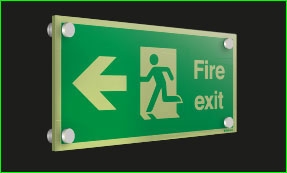Safety Way Guidance System: Lighting The Way to Safety
 What is a Safety Way Guidance System?
What is a Safety Way Guidance System?
A Safety Way Guidance System (SWGS) is a network of clear photoluminescent information, such as markings and directions, to ensure people can safely exit from anywhere inside a building, even with poor visibility or lighting. An effective SWGS conveys the required information in order for people to evacuate a building in an efficient and coherent manner to reach safety, in the event of a fire evacuation. Photoluminescent safety signs are central to these systems though neither the Health and Safety Regulation 1996 or The Regulatory Reform Order 2005 stipulate a legal requirement for their use.
Understanding BS ISO 16069:2017
A Safety Way Guidance System must conform to the standards set out in BS ISO 16069. This stipulates requirements that need to be met with regard to the design, installation and performance for both photoluminescent and electrical SWGS. Should a fire emergency occur, SWGS which are compliant with ISO 16069, offer clear and safe exit routes. The benefit of these systems is that they are coherent and understood by everyone, regardless of their culture or language. This means in an emergency, occupants can be guided out of the building safely to a designated assembly point. This is ensured as symbols must be compliant with BS EN 7010 and sign design must meet requirements of BS ISO 3864 parts 1-4, to conform to BS ISO 16069.
How photoluminescent signage works
Photoluminescent signage stores energy and then releases it later on in the form of a green glow. There is a plethora of photoluminescence forms with the simplest being fluorescence and phosphorescence. Phosphorescence is most commonly used in safety signage as it stores absorbed energy and releases it in low amounts over time. The latest tech serves up a dependable green glow for all signage even in the darkest conditions.
Benefits of photoluminescent signage
- Mitigates risks of slips, falls and injuries by clearly marking any hazards and obstructions
- Empowers people to follow a clear and unambiguous exit route during an emergency
- Ensures action or warning messages can be seen even during a blackout or in smoky environments
- Versatile and allows the use of Low-Location Lighting Strips, Stair Markers and Die-Cut Shapes among others for a more complete lighting setup
- Reduces egress times and streamlines the process of evacuating buildings
- Shows a duty of care for employees and any other person that may be in a building
- Reliable, cost effective and require minimal maintenance. A battery backup or additional power source is not required.
Installing a Safety Way Guidance System
Photoluminescent SWGS should aim to reduce confusion and delay and enable people to take in information quickly and easily as they navigate their way through a building. A few factors to consider include:
- Expected number of people utilising the route
- Features of occupants, including impaired vision, mobility or hearing
- Type of activity that is carried out in the environment
- Anticipated time delay before evacuation procedure
- Purpose of building including size, type and location
- Ensuring photoluminescent systems can be completely charged by maintaining sufficient exposure to light
- Emergency lighting currently in use
- Type and location of any potential escape routes
- Final assembly/refuge point locations
- Intricacy level of escape routes – probable areas of confusion
- Potential hazards which the user may come across
- Certain risk situations in which the escape routes will be used
- Current escape route features
Positioning photoluminescent signage is of paramount importance. UK Buildings Regulations 2010 state every doorway or exit providing access to a fire escape needs to have exit signage. Signs should be a maximum of 10m apart and placed at every junction or change in direction.
Download the full Seton guide to Photoluminescent Signage at https://www.seton.co.uk/photolumguide
